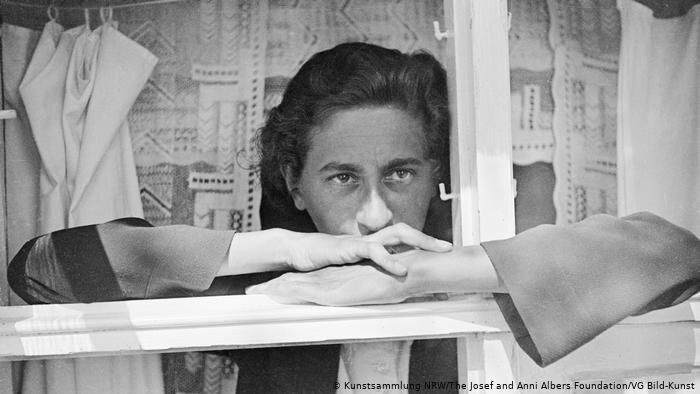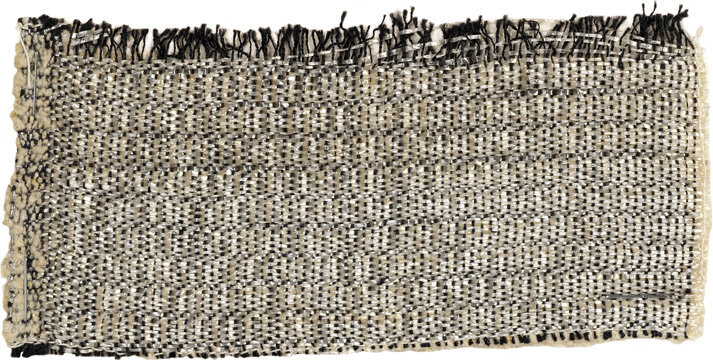Anni Albers
The Bauhaus’ leading textile artist, one of the inspirations for our latest limited-edition collection Women of Bauhaus
Anni Albers, courtesy of The Josef and Anni Albers Foundation
Our latest limited-edition collection takes inspiration from the radical design of the Bauhaus weaving workshop. The Bauhaus was a school founded in 1919 which offered workshops in both design and fine art practices, it aimed to combine the two disciplines to create beautiful pieces which matched form with function.
Named after one of the most celebrated Bauhaus artists Anni Albers, our Anni print reimagines her distinctive geometric designs and can be found across our papers …
“Being creative is not so much the desire to do something as the listening to that which wants to be done: the dictation of the materials.”
- Anni Albers
Artist Anni Albers radically transformed the way people thought about textiles. Her bold designs combined abstract motifs inspired by Paul Klee with modern materials such as cellophane to produce hardwearing and beautiful pieces that feel as modern as when they were first created. Albers’ focus on the tactility of her pieces is reflected across our latest collection with each of our notebooks filled with 128 soft white pages wrapped in a premium 300gsm card stock.
Anni Albers, Wall-Covering Material for the Bundesschule Auditorium in Bernau, Germany, 1929. Cotton, chenille and cellophane. Courtesy of The Josef and Anni Albers Foundation.
Like many of her contemporaries, Albers did not enrol in the Bauhaus with the intention of pursuing textile design but quickly became fascinated with the possibilities of weaving. “Fate put into my hands limp threads!” she later recalled. “Threads to build a future?”
Anni Albers Design for Smyrna Rug, 1925. Courtesy of MoMA.
Alongside the ever-evolving discipline of abstraction, Albers was also inspired by textile art from around the world. She was particularly fascinated by the pre-Columbian textile art of Peru and frequently made trips to ethnological museums such as Museum für Völkerkunde in Berlin and Munich to study Peruvian textiles in their collection.
The influence of Albers’ carefully balanced compositions of sharp squares and dynamic lines can be seen in our latest print which bears her name.
After fellow Bauhaus weaver Gunta Stölzl left the Bauhaus in 1931, Albers took up the position of head of the weaving workshop, a role she held until the Bauhaus was forced to close due to pressure by the Nazi Party in 1932. Together with her husband Josef Albers, Anni fled to North Carolina where the couple took up teaching posts at the influential and experimental Black Mountain College.
Anni Albers in her weaving studio at Black Mountain College, 1937. Courtesy of Guggenheim Museum Bilbao.
During this time Albers continued to produce textiles informed by her travels through Latin America which combined the traditional technique of backstrap weaving with her modern colour palette and abstract motifs. In 1949 she became the first textile artist to have a solo exhibition at MoMA, New York – an exhibition that established her as one of the most important designers of her day.
Anni Albers Rug, 1959. Courtesy of the Josef and Anni Albers Foundation.
Throughout the 1950s Albers produced the majority of her ‘pictorial’ weavings inspired by Andean designs, created mass-producible fabric patterns and wrote her hugely influential book On Designing, a collection of writings which continues to inform design practices today.
Anni Albers Black-White-Red, 1926/27. Courtesy of the Josef and Anni Albers Foundation.
We share Anni Albers’ focus on creating pieces as beautiful to use as they are to look at and, like Anni, find inspiration through researching design histories from across the world. Our new print Anni pays homage to her and recognises the incredible influence her dynamic textiles continue to have on modern design.






